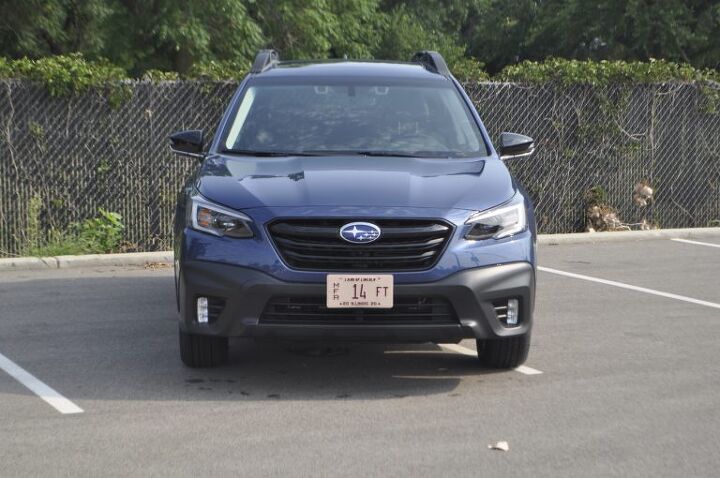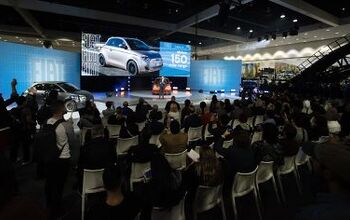2020 Subaru Outback Onyx XT Edition - Keeping the Wagon Flame Going

2020 Subaru Outback Onyx Edition XT Fast Facts
Subaru’s Outback has long been a standard-bearer for wagons. The addition of the Onyx Edition XT trim level for 2020 won’t change that.
Really, that’s the big news, and I don’t mean that sarcastically. While minor trim-level additions and changes sometimes seem so minor as to not be worth a review, this one is.
Mostly because any trim with “XT” in the name gets a turbocharged 2.4-liter turbocharged four-cylinder that makes 260 horsepower and 277 lb-ft of torque. It’s the first turbo in an Outback since early in Obama’s presidency – when your author was still (just barely) in his 20s. And yes, it’s a boxer. Naturally.
Other new for 2020 goodies include the tablet-style, 11.6-inch infotainment screen that has been popping up across the Subaru lineup, a hands-free power liftgate, a driver-distraction mitigation system, and the addition of advanced adaptive cruise control with lane-centering to Subaru’s already existing EyeSight safety suite.
Let’s start with the turbo. While it adds 111 lb-ft of torque and 78 ponies over the base 2.5-liter naturally aspirated boxer four it doesn’t exactly make the Outback swift. You won’t struggle in most situations, including merging, but you won’t blow anyone’s hair back, either. The words “fine” and “adequate” come to mind.
That applies to the ride and handling aspects, as well. The car is perfectly pleasant to drive, but not terribly dynamically engaging. It’s just, well, fine.
This isn’t really a problem, since the Outback is designed with safety and utility in mind. And it does what it’s supposed to well enough, or at least as well as I can tell – I didn’t actually take the Outback camping or load it down with kayaking gear. I suspect, however, if I needed to use it those ways, it would do quite well.
Yes, Subaru saddles this car with a CVT, and that may be part of why the Outback doesn’t necessarily feel quite punchy unless you use the paddles to replicate an eight-speed automatic. At least this CVT doesn’t drone or whine like some do. As you no doubt know, the Outback, like most Subies, is AWD.
As far as the other features go, the large tablet-like infotainment screen is an improvement over what Subie offered before, though the screen can still look a bit outdated in terms of fonts/graphics. One nice touch is how you can set it up to be a split-screen between Apple CarPlay and the Subaru system.
Part of the Onyx treatment is more-aggressive styling and blacked-out wheels. The overall Outback shape is retained, so the car still looks familiar, but there’s an aggro theme to it that will be off-putting to some. I am not sure that legions of families who buy Outbacks for safety and family trips to the trailhead were clamoring for a roided-up look, but then, I don’t have access to Subie’s internal customer survey data.
The specific exterior styling changes that Onyx brings include 18-inch wheels (blacked-out, as previously noted), a black finish to other elements such as the lower front bumper, and specific badging. The interior gets a gray two-tone treatment.
Interior controls are mostly what Subaru calls direct-touch, though buttons and knobs remain for certain functions, thankfully. Most notably that means there are knobs for the audio and buttons for the basic HVAC controls – temperature and defroster.
As for the updated EyeSight system, the lane-centering system does what so many others do these days – guide the driver back should he or she stray. Meanwhile, the driver-distraction mitigation system uses an infrared camera and facial-recognition technology to scan for signs of fatigue and/or distraction before alerting the driver. I found it to be a bit inconsistent – occasionally it would alert if you took your eyes off the road to say, change the radio station, but trying to trigger it by intentionally looking away from the road (when it was safe, of course) didn’t always work.
Other standard or available features include automatic emergency braking, lane-departure and sway warning, front-view monitor, rear-view camera, a traction-management system, LED headlights and fog lamps, Bluetooth, 18-inch wheels, Apple CarPlay, Android Auto, USB ports, Wi-Fi hotspot, heated front seats, dual-zone climate control, navigation, moonroof, wireless charger, and reverse automatic braking.
All for a price tag of around $37K.
In the end, the Outback remains what it always has been – a high-ground clearance (8.7 inches) wagon with an emphasis on utility and safety over performance. More-aggro styling and more guts don’t change that.
And that’s just fine (there is that word again). This is one of those “if it’s not broke, don’t fix it” situations. Outback buyers shop Subaru because of that emphasis on utility and safety, and the Outback still delivers.
Minor improvements to the infotainment system or a little more passing punch can’t hurt. But the formula works.
And it keeps one of the few wagons left on the road rolling strong.
[Images © 2021 Tim Healey/TTAC]

Tim Healey grew up around the auto-parts business and has always had a love for cars — his parents joke his first word was “‘Vette”. Despite this, he wanted to pursue a career in sports writing but he ended up falling semi-accidentally into the automotive-journalism industry, first at Consumer Guide Automotive and later at Web2Carz.com. He also worked as an industry analyst at Mintel Group and freelanced for About.com, CarFax, Vehix.com, High Gear Media, Torque News, FutureCar.com, Cars.com, among others, and of course Vertical Scope sites such as AutoGuide.com, Off-Road.com, and HybridCars.com. He’s an urbanite and as such, doesn’t need a daily driver, but if he had one, it would be compact, sporty, and have a manual transmission.
More by Tim Healey
Latest Car Reviews
Read moreLatest Product Reviews
Read moreRecent Comments
- 28-Cars-Later 2018 Toyota Auris: Pads front and back, K&N air filter and four tires @ 30K, US made Goodyears already seem inferior to JDM spec tires it came with. 36K on the clock.2004 Volvo C70: Somewhere between $6,5 to $8 in it all told, car was $3500 but with a wrecked fender, damaged hood, cracked glass headlight, and broken power window motor. Headlight was $80 from a yard, we bought a $100 door literally for the power window assembly, bodywork with fender was roughly a grand, brakes/pads, timing belt/coolant and pre-inspection was a grand. Roof later broke, parts/labor after two repair trips was probably about $1200-1500 my cost. Four 16in Cooper tires $62 apiece in 2022 from Wal Mart of all places, battery in 2021 $200, 6qts tranny fluid @ 20 is $120, maybe $200 in labor last year for tranny fluid change, oil change, and tire install. Car otherwise perfect, 43K on the clock found at 38.5K.1993 Volvo 244: Battery $65, four 15in Cooper tires @ $55 apiece, 4 alum 940 wheels @ roughly $45 apiece with shipping. Fixes for random leaks in power steering and fuel lines, don't remember. Needs rear door and further body work, rear door from yard in Gettysburg was $250 in 2022 (runs and drives fine, looks OK, I'm just a perfectionist). TMU, driven maybe 500 miles since re-acquisition in 2021.
- 1995 SC I never hated these. Typical GM though. They put the wrong engine in it to start with, fixed it, and then killed it. I say that as a big fan of the aluminum 5.3, but for how they were marketing this it should have gotten the Corvette Motor at the start. Would be a nice cruiser though even with the little motor. The 5.3 without the convertible in a package meant to be used as a truck would have been great in my mind, but I suspect they'd have sold about 7 of them.
- Rochester I'd rather have a slow-as-mud Plymouth Prowler than this thing. At least the Prowler looked cool.
- Kcflyer Don't understand the appeal of this engine combo at all.
- Dave M. This and the HHR were GM's "retro" failures. Not sure what they were smoking....







































Comments
Join the conversation
I've been driving a 2021 OB XT for nearly 3 months now after a stolen car destroyed my '18 Forester XT. The Outback is not a perfect car, none are, but in terms of driving dynamics, build quality, and interior materials it is as good or better than the Highlander, Pilot, and Escape that I cross-shopped. Also cheaper when optioned similarly, at least in Canuckistan. The Outback XT is rigid, quiet, and very comfortable to drive. It is also considerably quicker than most of the competition at 5.9 seconds 0-60 (Motor Trend, FWIW) and quite entertaining to accelerate around corners while the torque vectoring does it's thing. To find the acceleration merely adequate Tim must be accustomed to driving seriously quick cars. I'm envious. The CVT works just fine. Under hard acceleration it has 8 steps which mimic a multi-speed planetary transmission - without the annoying gear hunting that plagues some of those devices. Biggest benefit of the CVT is on the highway, where the CVT seamlessly chooses ratios as the terrain changes. I have no hesitation calling it a wagon. Compared to the taller Honda and Toyota products I drove, it leans much less in corners and feels much more planted. It actually is quite fun to drive, which cannot be said about most new SUV's. I do have some nits with the car: the electric nannies are sometimes annoying, though a new software update will make it easier to turn at least one of them off. Placing the seat heater controls 2 menus deep is also dumb, Subaru. Finally, the throttle tip-in is not linear; it takes more movement at the beginning of the gas peddle stroke to make things happen than it does when your foot is well into it. All-in-all I am quite happy with the OB. I do sometimes miss the hooligan antics of my turbo Forester, but the smoother (and faster) acceleration of the OB, along with the far superior ride and rigidity are a fair trade-off, in my opinion.
This seems pretty slow for the price you're paying. caranddriver.com/reviews/a28531970/2020-subaru-outback-drive/ It isn't a dangerous situation or anything but I think Outback owners should be honest that they're happy as long as they can outrun the garbage truck rather than try to twist around that either engine turns in above average performance for 2021.